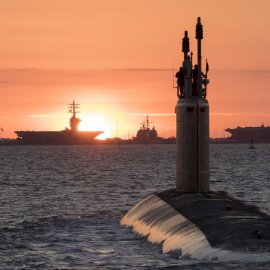Underwater War: Marine Tech in the Information Age
-
English
-
ListenPause
[intro music] Welcome to World Ocean Radio… I’m Peter Neill, Director of the World Ocean Observatory. Nations have been won and lost by war at sea. We think often of ships for exploration and trade, but those activities progressed into value that defined power—the prospect of imperial reach and colonial expansion across the oceans to every other nation connected by the sea. The power was sea power, and for centuries the fleets of England, France, the Netherlands, Spain, Russia, and the United States projected global influence and aspiration, augmented and protected assets, and defined the intercourse of nations. Certain technical achievements enhanced these powers: charts and navigational instruments, steam power supplanting sail, increased armament and accuracy of weapons on-board and along-shore, the airplane, nuclear power, the submarine. This latter advanced naval warfare from two to three dimensions, upset all the historical rules of engagement, and provided an invisible array of weapons for both offense and defense that demanded an entirely new way of waging war at sea. Submarines, armed with torpedoes and missiles, belittled the scale of ever-larger warships—cruisers, battleships, aircraft carriers—that suddenly needed protection by escorts and defensive weapons against the threat of attack by small, surprisingly unseen enemy vessels that could penetrate the deep water and lurk in the shallows. Counter-measures were required and a wave of new technical and tactical weapons evolved: sonar, satellite, and stealth as a means to seek and destroy. The identification and monitoring of larger and more effective submarines became a modern fixation in response to the destabilized and contradicted conventions of naval engagement. As technology has expanded on every other front, so too has this evolution of sub-sea activity reacted. A recent article in “Marine Technology Reporter” (LINK: https://magazines.marinelink.com/magazines/MarineTechnology/201809/pdf/) enumerates some of the advances now being deployed. They seem to manifest in support of two strategies. The first strategy is particularly defensive: to turn the underwater zone into a vital space enhanced by sensitive recording that provides complete information regarding detailed ocean conditions and the sea floor, the detected movement of any large object underwater (including whales), and the changing aspects of the water column that might provide better classification of threat and early warning, and affect the efficiency and accuracy of detection and delivery. The second strategy is primarily offensive: to use unmanned, automated, robotic vehicles that can be profuse, inexpensive by contrast to surface craft, carry larger and more effective payloads, and be operated autonomously using artificial intelligence and remote control from land-based centers, expanding “the battle space” at lower cost, higher success, and no loss of life. That is, unless you are on the receiving end of these attacks. We know that we live in an information world. He who has the most data wins. We seem to be heading for a new kind of warfare where comprehensive measurement arrays provide strategic awareness of the battlefield, computers recognize classifications, potentials, and false signals, multiple systems provide analysis of specific tactical options and response, artificial intelligence calculates the probabilities, concludes, and issues the command, and algorithms on and off-board execute the offensive or defensive action and the engagement is won. I often walk along the ocean edge, stimulated to think about what is out there, in a dynamic space that I cannot see. I think of the food chain, a constant feeding up and down of creatures that need each other to survive. It is a hard world out there, lots of threats and enemies, in the deep ocean and lurking in the shallows. But what else is there that is invisible to me? The beams of searching electrons, the devices fixed to the dark soundings, the sleek engineered constructs that float and glide, follow paths of directed light, listen and feel the marine environment around, collect and evaluate the data that even in its minutia contributes to the great geo-political conversation and the exercise of power? Is that what is going on the great world ocean? Or is it something else? We will discuss these issues and more, in future editions of World Ocean Radio. WORLD OCEAN RADIO IS DISTRIBUTED BY THE PUBLIC RADIO EXCHANGE AND THE PACIFICA NETWORK FOR USE BY COLLEGE AND COMMUNITY RADIO STATIONS WORLDWIDE. FIND US WHEREVER YOU LISTEN TO YOUR FAVORITE PODCASTS AND AT WORLD OCEAN OBSERVATORY DOT ORG. [outro music]
Ships have long been used for exploration and trade, as well as for colonial expansion and conflicts at sea. We are using technological achievement to advance global influence, and the rules of engagement are ever-changing. In this week's episode of World Ocean Radio we share new technologies that accelerate sub-sea activities, some of the new technological achievements now being deployed, and the ways that the underwater zone is being used for offensive and defensive strategies in the modern age.
About World Ocean Radio
Peter Neill, Director of the World Ocean Observatory and host of World Ocean Radio, provides coverage of a broad spectrum of ocean issues from science and education to advocacy and exemplary projects. World Ocean Radio, a project of the World Ocean Observatory, is a weekly series of five-minute audio essays available for syndicated use at no cost by college and community radio stations worldwide.
Resources from This Episode
- Marine Technology Reporter, Sept. 2018
Image Credit
- Nuclear Stealth Submarine | National Interest.org
- Login to post comments



